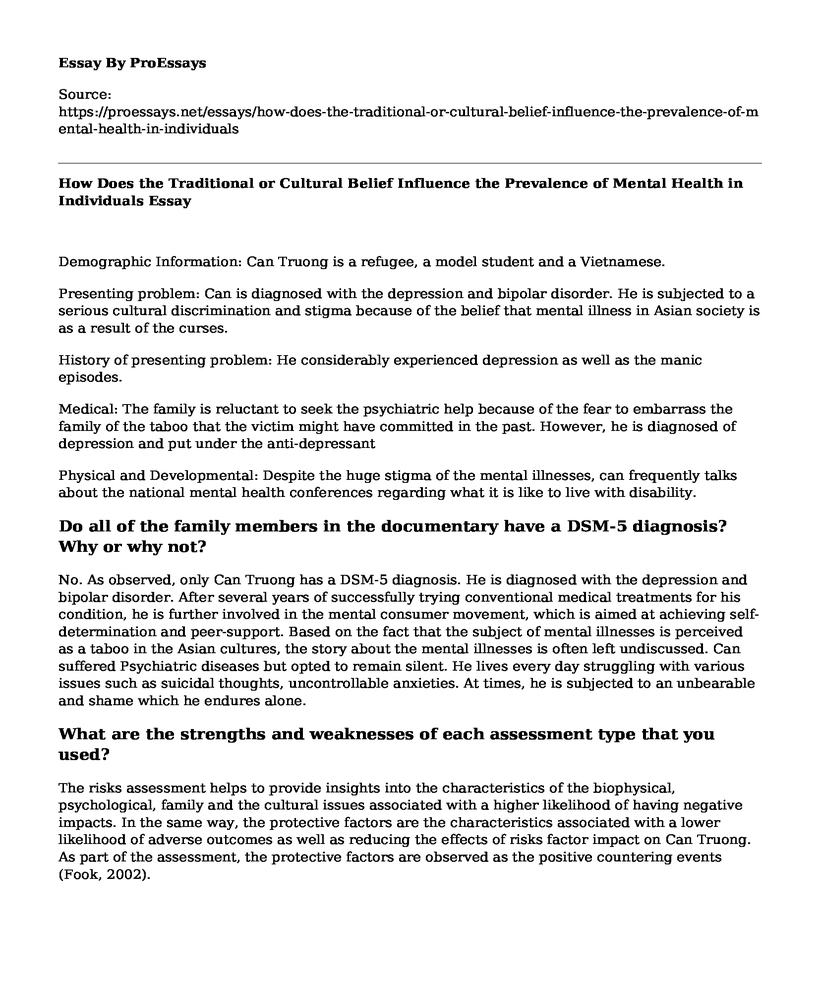Demographic Information: Can Truong is a refugee, a model student and a Vietnamese.
Presenting problem: Can is diagnosed with the depression and bipolar disorder. He is subjected to a serious cultural discrimination and stigma because of the belief that mental illness in Asian society is as a result of the curses.
History of presenting problem: He considerably experienced depression as well as the manic episodes.
Medical: The family is reluctant to seek the psychiatric help because of the fear to embarrass the family of the taboo that the victim might have committed in the past. However, he is diagnosed of depression and put under the anti-depressant
Physical and Developmental: Despite the huge stigma of the mental illnesses, can frequently talks about the national mental health conferences regarding what it is like to live with disability.
Do all of the family members in the documentary have a DSM-5 diagnosis? Why or why not?
No. As observed, only Can Truong has a DSM-5 diagnosis. He is diagnosed with the depression and bipolar disorder. After several years of successfully trying conventional medical treatments for his condition, he is further involved in the mental consumer movement, which is aimed at achieving self-determination and peer-support. Based on the fact that the subject of mental illnesses is perceived as a taboo in the Asian cultures, the story about the mental illnesses is often left undiscussed. Can suffered Psychiatric diseases but opted to remain silent. He lives every day struggling with various issues such as suicidal thoughts, uncontrollable anxieties. At times, he is subjected to an unbearable and shame which he endures alone.
What are the strengths and weaknesses of each assessment type that you used?
The risks assessment helps to provide insights into the characteristics of the biophysical, psychological, family and the cultural issues associated with a higher likelihood of having negative impacts. In the same way, the protective factors are the characteristics associated with a lower likelihood of adverse outcomes as well as reducing the effects of risks factor impact on Can Truong. As part of the assessment, the protective factors are observed as the positive countering events (Fook, 2002).
Which social work theories did you apply to the assessments? Why?
I applied various social work theories in the assessment. Firstly, the psychodynamic theory helped to explain the personalities of the individuals in the assessment regarding the conscious and unconscious forces. On a broader note, the theory further describes the personality of the individuals as some something that consists of identity, the superego, and the ego (Simmons Staff, 2014).
The transpersonal theory was also vital for this assessment as it proposed the additional stages beyond the ego demonstrated by the adults (Craft & Landers, 1998). In healthy individuals, the stages often lead to various elements such as the creativity, wisdom as well as the altruism. In the case study, Can lacks a healthy ego development, and this subjects him to the severe situation of experiencing depression and stigma. These conditions are associated with taboos according to the Asian cultures and religion (Craft & Landers, 1998). This is why the mother believes that can suffer from these psychiatric disorders because he had committed sins in his past life. Her Buddhism religion influenced these thoughts.
What questions do you have about doing assessments after having completed them, particularly about ethnicity/diversity, lower SES, and social justice?
How does the traditional or cultural belief influence the prevalence of mental health in individuals?
Pressure to conform to societal norms of individuation affects the psychological health statuses in individuals?
References
Craft, L. L., & Landers, D. M. (1998). The effect of exercise on clinical depression and depression resulting from mental illness: A meta-analysis. Journal of Sport and Exercise Psychology, 20(4), 339-357.
Fook, J. (2002). Social work: Critical theory and practice. Sage.
Simmons Staff, (2014). Theories Used in Social Work Process and Practice Model. Social Work Simmons
Cite this page
How Does the Traditional or Cultural Belief Influence the Prevalence of Mental Health in Individuals. (2022, Jul 07). Retrieved from https://proessays.net/essays/how-does-the-traditional-or-cultural-belief-influence-the-prevalence-of-mental-health-in-individuals
If you are the original author of this essay and no longer wish to have it published on the ProEssays website, please click below to request its removal:
- Sexism and Social Justice - A Sociology Essay Example
- Should Drug Abuse Moms Be Granted Custody of Their Infants After Birth: The Ethical Issue
- Essay Example on Mass Media: Essential Agents of Socialization and Mental Health
- Gender Diversity in Business: Exploring Its Meaning and Impact - Research Paper
- Paper Example on the Rise and Fall of the Border Wall Concept
- Essay Example on Pavel and Sophie's Promise: Understanding Morals and Love
- Community Resilience - Essay Sample







